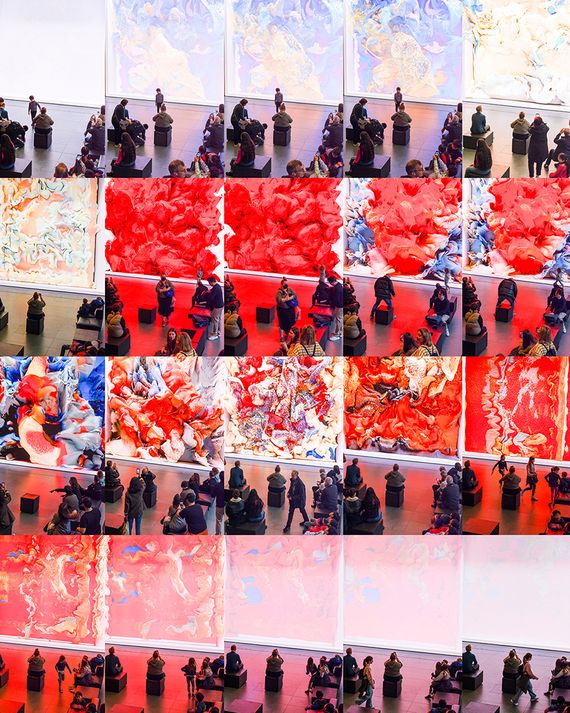
This article was featured in One Great Story, New York’s reading recommendation newsletter. Sign up here to get it nightly.
In the lobby of the Museum of Modern Art stands a 24-foot-tall screen that emits a continuous flow of psychedelic slush and bacterial blobs. People stare, dance, and make Instagram reels in front of it, as an electronic score plays and pulpy Nerf shapes splash over its trompe l’oeil edges. The whole thing looks like a massive techno lava lamp. This is Refik Anadol’s Unsupervised, some cross between relaxation exercise and euphoric TED Talk and NSA levels of data mining. It’s a smash success.
With the help of a 15-person studio, the Turkish-born, Los Angeles–based Anadol has used artificial intelligence to reinterpret the metadata that comprises the online database of MoMA’s immense collection. That’s 138,151 records, according to the museum, “freely available on GitHub.” The results are cool patterns that recall digitized versions of van Gogh paintings morphing into paintings that look like Monet’s, which then turn into de Koonings or Frankenthalers or Rothkos, into sandstorms and mashed potatoes and other things that sort of look like art. These are interspersed with sequences that look like charts, diagrams, waves, and other amorphous stuff. It all adds up to a narcotic pudding. Just as we have smart appliances to monitor steps, heart rate, and sleep patterns, so are we now scanning museum collections. Call it search-engine art — a new dataism that programs the history of modernism so we can see everything all at once.
According to Michelle Kuo, the curator responsible for this pointless museum mediocrity, Unsupervised “reshapes the relationship between the physical and the virtual, the real and the unreal,” and “explores dreams, hallucination, and irrationality, posing an alternate understanding of modern art.” But really, Unsupervised is a digital version of the dead-on-arrival Zombie Formalism of the 2010s that saw young painters making abstract paintings that looked like other, already famous abstract art.
Unsupervised is mildly entertaining for whole minutes at a time. There are chairs and couches strewn in the lobby. You can lounge and look. It takes about 30 seconds to have an idea what this is and what it’ll do next: a suggestion of Impressionism, some cubic forms, more blobs and waves, modern art mashed together. It’s comforting, really. Unsupervised has the virtue of not disturbing anything inside you; it triggers no mystery. With all due respect to Kuo, it has neither dreams nor hallucinations and takes away art’s otherness. In this hypercontrolled, antiseptic setting, art and doubt maintain separate bedrooms. It’s like looking at a half-million-dollar screensaver.
These days, works like Unsupervised travel the biennial and museum circuit. Thanks to social media and the dictates of the market, high art and mass entertainment have never been so intertwined. A morphing Anadol was the backdrop for this year’s Grammys. Tourists flock to immersive experiential installations dedicated to Kahlo, Monet, van Gogh, Klimt, and King Tut — all cousins of Anadol’s shape-shifting Instagram-background fodder, often set to uplifting, whooshing music. It’s spilled into public space. Witness Anish Kapoor’s shiny silver bean shape squashed under a starchitect building in Tribeca. It isn’t sculpture as much as a schlocky foyer for the super-wealthy who live above. Already, people stand around it and take selfies. Or consider Louis Vuitton’s Yayoi Kusama marketing display, where we see an animatronic Kusama with dead eyes painting polka dots in the window of its Fifth Avenue store. People gather, gawk, brandish their phones.
At the turn of the century, artists like Jason Salavon and the late Jeremy Blake created digital transformations that sampled, scrambled, and recombined patterns based on art. Unsupervised adds nothing but scale and expense to the mix.
Anadol talks in a curatorial mumbo-jumbo about “meaningful and cutting-edge data visualization techniques” that can have “healing power.” He says people have been moved to tears by his work, asking him for hugs. This messianic blather about making the world better for people echoes the language of Silicon Valley. Anadol wants to create “poetic algorithms for new meditative experiences in the metaverse.” He should work at Facebook.
The problem is not museums bringing new art, technologies, and audiences into their institutions. Museums took a huge attendance hit from COVID. We should not begrudge an institution that feels pressure to offer easily digestible digital merriments alongside its traditional fare. The problem with Unsupervised — a problem it shares with other AI programs that use existing written, photographic, and artistic material for their creations — is that it’s derivative and familiar and struggles to transcend its source material. Instead of offering something new, MoMA’s foray into AI is already months behind the curve, failing exactly where other AI programs have failed. If AI is to create meaningful art, it will have to provide its own vision and vocabulary, its own sense of space, color, and form. Things Unsupervised lacks.